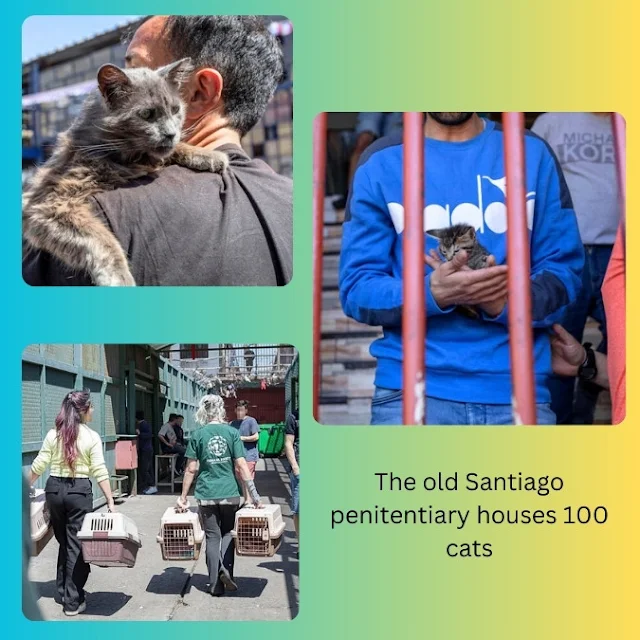There is a prison in Chile where the inmates look after almost 100 cats. It is Chile's largest and oldest prison in which there are 4,900 inmates. It is the El Centro de Detención Preventiva (CDP) Santiago Sur, better known as the old Santiago penitentiary and locally, simply ‘la Peni’. It was built 180 years ago.
 |
| The image is by MikeB based on pictures provided by Metro.co.uk who I presume got them from HSI. |
The cats roam around inside the prison with the inmates. How did the cats arrive at the prison? Well, I'm told that they had a rodent problem and administrators decided to introduce cats to the prison to keep them down.
The problem was that they had no sterilisation programme and the cats that they adopted had not been sterilised. They procreated until the numbers grew to almost 100. A small oversight :) . But perhaps there is a silver lining.
The cats appear to be helping the inmates. Looking after them gives them a sense of responsibility. And cats of course are non-judgemental unlike society and the administrators of the prison.
Many of the prisoners have a compassionate and close bond with a cat or cats and they join them in their cells. They sleep on makeshift cat beds.
The cats are fed with leftovers from human food. The inmates can't bring in cat food. This would appear to be a potentially serious problem because human food is okay for a short time but over a long period its unbalanced nature, lacking in certain nutrients, may cause illness in domestic cats.
Sometimes the inmates forego their food to feed the cats. Another problem is with pooing and peeing as you might imagine. I don't think that there are any litter trays and so there is a problem with poop and urine.
Thirdly, they can't take the cats to a vet if they become ill. This is apparently the major concern of the prisoners: the lack of access to any veterinary care.
And it appears that the Chilean Protection charity, Felinnos Foundation, proposed visiting the prison to help deal with these problems and to give the cats a much needed check-up.
The administrators were hesitant about the idea. They relented because of the ongoing hygiene problems with poop and pee and opened the doors to the charity. The Humane Society International helped organise the visit.
And at this time, the authorities have begun to understand that the cats are important to the inmates. They rely upon them for emotional support. And the security guards are helping as well.
A Humane Society International worker, said that the living conditions at the prison were extremely challenging for both the inmates and the cats. Some cats were suffering from health problems. These included the typical ear and eye infections i.e. upper respiratory tract infections.
And apparently the cats harboured fleas and ticks and they had worms and skin rashes combined with malnutrition and wounds. The wounds were acquired through fighting. Quite a difficult situation in terms of health which I guess is to be expected under the circumstances.
The charity provided healthcare for the cats over three days with the cooperation of the country's national prison service.
There were given full check-ups and they were spayed and neutered so that they could no longer procreate. They were also vaccinated against rabies.
The cats were then reunited with their prisoner caregivers after a night of isolation and observation.
Further, the inmates were given some advice about how to care for their feline companions in this very particular environment.
The prison is very overcrowded with double the number of inmates that should be there. The Humane Society International worker, Daniela, said that "It's heart-warming to see the special bond and commitment that cats offer their guardians through their company and emotional support."
Comment: I've never heard of such an arrangement. I've heard of cats in prison but never to this extent and it's nice to know that the authorities have allowed the Humane Society to become involved in the interest of the welfare of the cats whose presence is obviously beneficial to the inmates but at a price: their health.
The question now is whether the authorities are going to put in place some better arrangements such as adding cat litter trays, ensuring that proper cat food is available and allowing the cats access to veterinary care. These are big changes to make and at the moment I don't have information as to whether these have been arranged.
-----------

No comments:
Post a Comment
Your comments are always welcome.